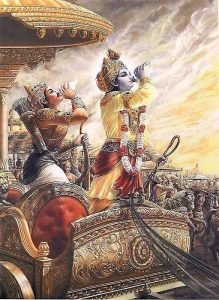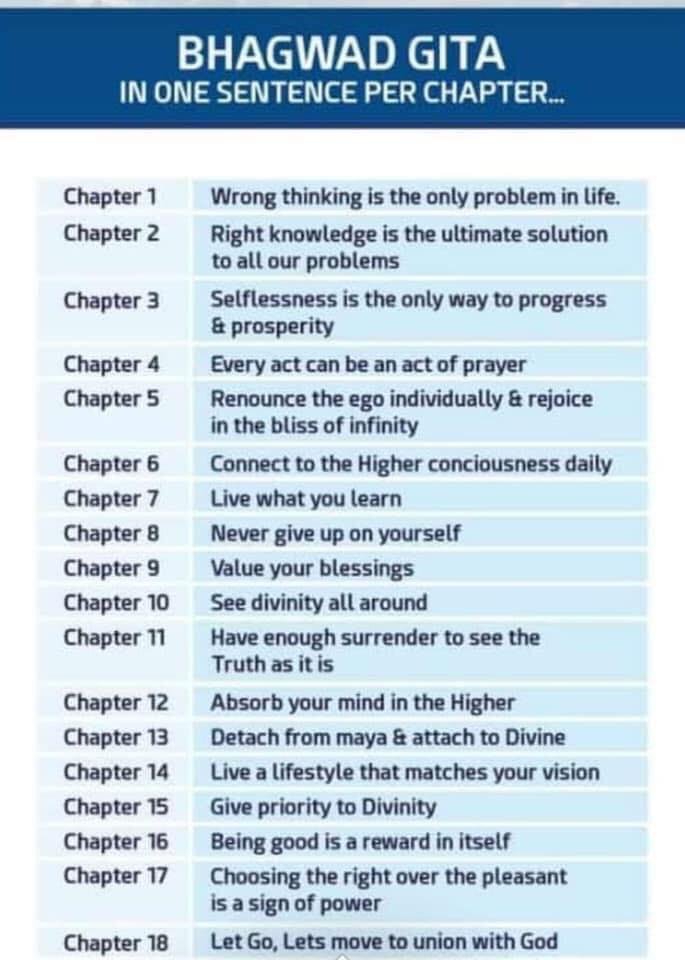Introduction
The Bhagavad Gita is one of the outstanding religious classics of the World. The book itself, comprising eighteen chapters (700 slokas or verses), forms an integral part of the great epic, Mahabharata which consists of 18 parvas (parts or books). Bhagavad Gita appears in Bhishma parva – chapters 25 to 42. It is in the form of a dialogue between Sri Krishna and Arjuna on the battle field of Kurukshetra.
Among the priceless teachings that may be found in the great Indian epic Mahabharata, there is none so rare and priceless as the Gita.
– Annie Besant (1847-1933),
a prominent Theosophist and a notable political leader during India’s freedom struggle

The Teacher
The teacher of the Bhagavad Gita is Sri Krishna, who is regarded by the Hindus as an avatar or incarnation of God Himself. He is the ideal of perfection for all times. The greatest hero, the most illumined scholar, the wisest statesman, the ablest politician, the mightiest warrior, the lord of yoga and the most supreme seer of the age that Krishna was. He offered himself as the humblest servant of humanity.
The Student
Arjuna, the recipient of the teaching, though himself a great warrior, is a typical representative of the humans, vulnerable to be upset or confused during periods of crisis. The questions and doubts he rises and the solutions that Sri Krishna offers are not only relevant but also valid even today.
When disappointment stares me in the face and all alone I see not one ray of light, I go back to the Bhagavad Gita. I find a verse here and a verse there, and I immediately begin to smile in the midst of overwhelming tragedies – and my life has been full of external tragedies – and if they have left no visible or indelible scar on me, I owe it all to the teaching of Bhagavad Gita.
– Mahatma Gandhi
Date and Author

Since the Bhagavad Gita is an integral part of the great epic Mahabharata, its date and authorship are obviously those of the epic itself. It is highly proclaimed to have been written by Lord Ganesh as poetically dictated by Rushi Veda Vyasa by his clairvoyant vision of past, present and future. The Mahabharata is estimated to have been compiled about 5000 years ago (3139 BC) along with other books of age old wisdom – the Vedas, the Upanishads and the Puranas.
Benefits of Studying Gita
In today’s world of growing consumerism and rising violence – leading to restlessness, anxiety and confusion in life – the Gita’s teachings are becoming even more significant than ever before. They are an eternal spring of wisdom required for developing right judgement, emotional balance, strength and for discovering the ultimate nature of human life. Gita contains everything required for a person who wants to live a life of meaning and fulfilment.

Bhagavad Gita is a practical manual for daily living in any age, in any religious tradition and its teachings can be applied to solve the problems facing us in modern life. Today there is an urgent need for such a manual. In spite of all our technological advances and material prosperity, we have no peace of mind and live in fear and anger in the midst of increasing violence. Gita offers solutions to all the contemporary problems familiar to all of us.
When I read the Bhagavad Gita and reflect about how God created this Universe everything else seems so superfluous.
– Albert Einstein, Scientist and Nobel Laureate
The Context – Birth of Bhagavad Gita
The context is the Mahabharata war between the Pandavas and Kauravas about to start in Kurukshetra battle field. The Pandavas were fully convinced that this was a Dharma Yuddha and resorted to only as a final measure after all peaceful efforts to restore to the Pandavas their legitimate Kingdom, taken away by deceit by the Kauravas, had failed.
The Gita is one of the clearest and most comprehensive summaries of the Perennial philosophy ever to have been done. Hence, its enduring value, not only for the Indians, but for all mankind.
– Aldous Huxley (1894 – 1963), an eminent English Writer and noted philosopher.
The Bhagavad Gita is perhaps the most systematic spiritual statement of the Perennial philosophy.
Just before the start of the war, Arjuna requested Sri Krishna, the charioteer, to stop the chariot in between the two armies to have a view of the Kaurava army. Arjuna saw all the elders like the Bhishma and Guru Dronacharya, Kauravas and other close relatives. Arjuna was highly disturbed. This emotional attachment led in turn to a profound grief in his mind. Arjuna could not imagine the situation that he has to fight with his loved relatives in this war and was in a state of intellectual dilemma with regard to what is dharma (right) and what is adharma (wrong). The war suddenly appeared to be unjustified because of this confusion born out of attachment and sorrow. He, hence, lays down his bow and declares that cannot fight such a ruthless battle.
The teachings of Krishna as taught by the Gita are the grandest the world has ever known. He who wrote that wonderful poem was one of those rare souls whose lives send a wave of regeneration through the world. The human race will never again see such a brain as his who wrote the Gita.
– Swami Vivekananda
Arjuna ultimately surrendered to Lord Krishna seeking a solution for his confusion and guidance for proper action. At this juncture, Sri Krishna, acting as his true friend, guide and guardian, counsels him on his duty and on his ideal attitude to life and action that a man should adopt. It is this teaching which is enshrined in the Bhagavad Gita, which has become an ultimate scripture.


Need of the hour where everyone is glued to their phones. Knowledge is power, for Hindutva is a way of life based on knowledge.
Excellent sir explanation of the theme is easily must understand every single person. Hope you may wrote some more books on related with lord Krishna. Thank you sir.
Very beautifully and with a lucid style of explanation one can easily know the lord krishna.besides narration noted quotes by eminent foreign philosopher’s is a welcome sign.besides these expecting the versus of great rushi’s and saints from ancient bharat about bhaghavat geetha and supreme god lord krishna
Most useful for Present generation
Very good initiative in present scenario. It is very helpful for people who can not spend much time to read entire Geetha. Given very good explanation to very important slokas in Geetha.